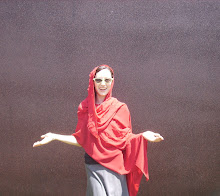NYC Amnesty/St. Bart's
Here is the paper I wrote for the President's Humanitarian Award I recieved for my Amnesty internship this past summer. I really enjoyed writing this bit of prose and think it offers a step inside the experience I am profoundly thankful for. I recorded a speech for Chapel that was a shortened version of this piece they played in late October at the WJC- as far as I know it went pretty well :*)
The President’s Award for
Humanitarian Service 2005
Choosing to Begin
To begin sometimes seems to admit some sort of end. I think part of me is involved in some adamant retort against these endings. I’d like to think of everything enflamed in one revolving continuum, beginning to begin and begin again. Or perhaps it’s just that voice whispering from inside of me that’s threatening to steal my memories, things I cannot forget. I know that I cannot shelve my summer in
There were the inmates, the farmers, the sisters, the wardens, detainees, the mothers and grandfathers, the captured sons just a bit younger than myself, the terrorists, the victims turned conquerors, the dead, the policewomen, the ordinary people with striking visions; all these webs of life I was connected to through my work on 8th Avenue and 34th Street. They have unknowingly woven their invisible subtleties into my eyes, my hands, my mind. Striking like cut glass glinting in the sunlight, these snippets of stories are portraits frozen in time. They piece themselves into a worn quilt enflamed in blazing colors and swerving shapes. Though I will never meet them, I feel as though I have known them because I have ached with them and moved beneath the gift of their sorrow or scorn attempting to piece together a flank of understanding. Somehow I can hope that I am dancing a timid step towards the change that could keep some of these stories from resurfacing with different names and faces. Just maybe.
Stepping into the head organ of Amnesty International USA pushed me in directions that contrasted and complimented the activism and advocacy I had previously done on my own at William Jewell. To break down Amnesty into the simplest of forms, I would say at its foundation it is the sum of two main parts. True to form as it originally began, Amnesty is simply people. It is the conglomeration of grass-roots chapters, ordinary people like you and me, bound together with a basic, common goal: to prevent prisoners of conscious from being isolated and forgotten and to educate and engage each other on humans rights issues. We write letters to czars, prime ministers, diplomats, judges and presidents. We hold vigils, sign petitions, invite speakers, play music and make as much noise as we see fit to raise awareness, or in other words, connect our communities, friends and families to a bird’s eye perspective. One that allows us to apply values mirroring our constitutional freedoms and rights to our world- the neighboring and the distant.
The other half of the equation is the work I dove into this summer. Besides domestic activism and education, Amnesty is also research and investigation, keen and watchful and detailed. Every year Amnesty releases reports detailing relevant human rights issues around the world. This summer, for example, I worked on research for reports dealing with issues in the United States involving violence against Native American women in the Navajo Nation, public housing for domestic violence victims, police brutality against lesbian, gay, bisexual and transgender persons, as well as custodial sexual misconduct in prisons between inmates and guards.
As a full-time research intern, I was in for a three-month submersion into the bustling world of an international human rights, NGO employee- this was a real job. No donut toting, coffee fetching, copier jamming or stereotypical gofer intern tasks were ahead of us. We wrote briefs, edited reports, researched and scanned and picked through details, called attorney generals, e-mailed activists, contacted lawyers and victims, mailed packages bursting with information to every Department of Corrections commissioner, and read document after document on government housing policies. The list could go on for reams. Although it was challenging, tiring and even tedious at times, it was also engaging, interesting and well worth the challenge. We had to apply ourselves to some finely-tuned tasks, especially when Amnesty’s International Secretariat in
Although I admit that I am guilty of a somewhat colorful history involving hopeless idealism, I do try to keep my sights on somewhat. I cannot say that Amnesty wasn’t immune from the quirks and competitions hidden within any large organization or business, but I can say that it is an organization that attracts a distinct array of hard working individuals who are focused and passionate, a virtue that I think keeps those kinds of distractions at bay. Half the experience was interacting with these valuable people and participating in the various opportunities within
In addition, I had the privilege of stumbling upon certain community of individuals hidden away in the basement St. Bartholomew’s Episcopal Church. I didn’t know it that first week, but this tiny hub of service would become a glowing part of my
The common thread that linked me from William Jewell to
Mary and the late John Pritchard, the couple whose careful generosity transformed my wild idealist jaunt into a throbbing reality by funding my way, are ultimate examples of this kind of sight and action. I want to thank them a million times over for this gift of experience they gave me- what more could I really ask for? I can only hope that we may all be able to take a cue from their peace and keep moving forward giving what we can each day, to choose to keep beginning.


0 Comments:
Post a Comment
<< Home